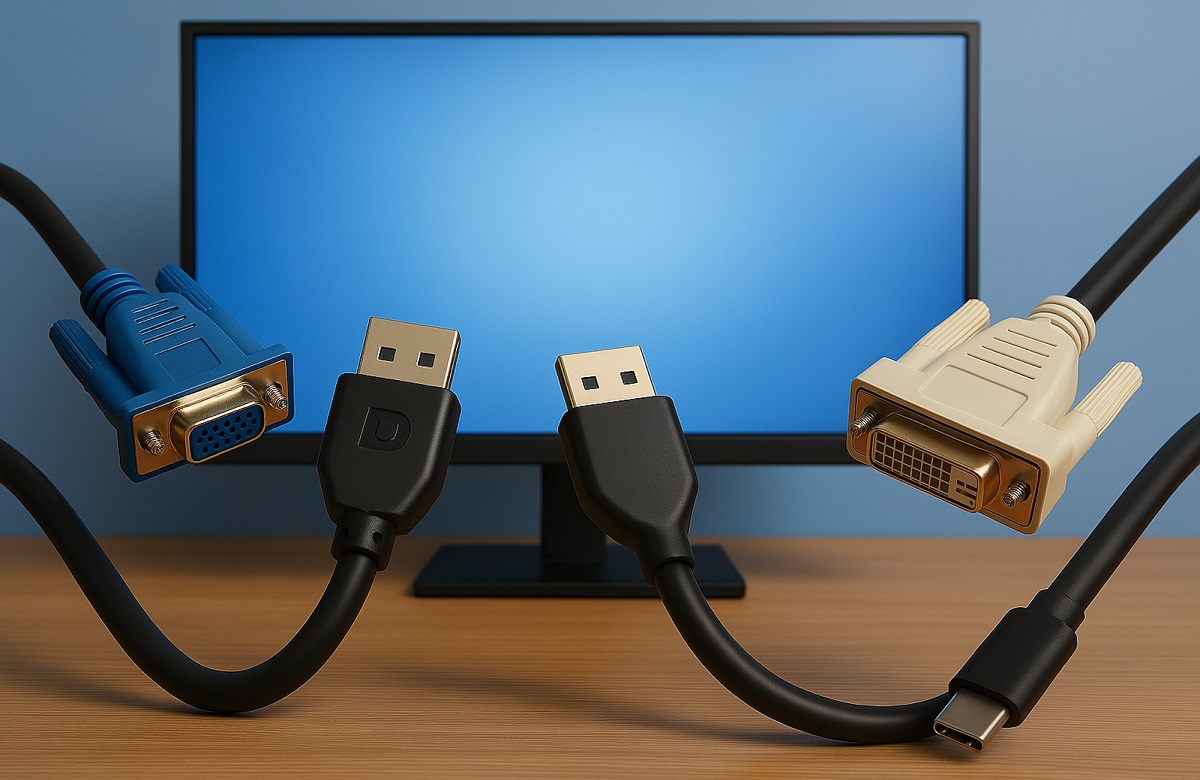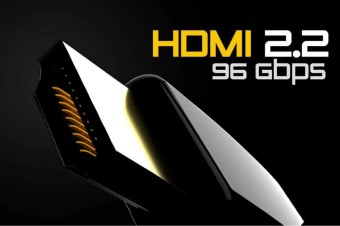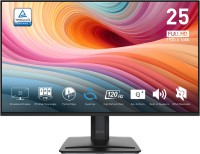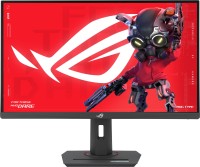Best Way to Connect a Monitor: HDMI, DisplayPort, VGA, DVI, USB-C
We independently test the products and technologies that we recommend.

1. VGA and DVI
Some monitors, even in 2025, feature an analog VGA video input. Objectively, this is an outdated technology with low bandwidth, standard resolution no more than 1280x1024 pixels, and an old-school screen aspect ratio of 5:4.
Theoretically, a VGA port can produce an image with a resolution of 2048x1536 pixels and a refresh rate of 85 Hz. However, in practice, the analog interface is largely prone to interference and noise, which means there is a higher likelihood of complaints about the picture, even if the clarity and fluidity of the video sequence are satisfactory.

Graphics card manufacturers, NVIDIA and AMD, no longer utilize VGA. However, it can still be found on motherboards with integrated graphics. Today, relying on VGA is definitely not advisable, and choosing a monitor with this connector is only reasonable when paired with old equipment, for example, an analog video recorder.
The DVI interface is slightly newer. Its current versions, DVI-D and DVI-I, allow for digital data transfer, coding, and interference protection, hence a somewhat better video signal quality. Modern versions of the interface support a Dual Link mode, providing bandwidth up to 2560 by 1600 pixels at a refresh rate of 60 Hz. However, in a single-link format, the maximum is a Full HD image.
There are three DVI plug and cable options:
- DVI-A — analog, like VGA, almost never used anymore;
- DVI-D — digital, still used in monitors, desktops, and graphics cards;
- DVI-I — combined, capable of transmitting both analog and digital video signals. Today, it appears only on old discrete graphics adapters.

Overall, for an office or educational PC and other tasks where high detail and refresh rate are not required, the DVI interface is appropriate, but de facto it is also outdated, with HDMI being its evolutionary successor. Signal transfer-wise (electrically), they are mutually compatible, so a simple and inexpensive passive adapter is suitable for connecting a monitor to a graphics card with this pair of interfaces (or vice versa).
2. HDMI
Today, HDMI (High Definition Multimedia Interface) is the most popular wired means of transmitting video (and audio too). For example, it is the industry standard in the television and gaming console markets, meaning it is practically the sole option for them. When it comes to connecting monitors to PCs and laptops, HDMI also leads, although it has worthy opponents in this niche.
Physically, HDMI implementation at the plug level can vary, specifically:
- full-size form factor — simply HDMI or Type A;
- mini version — miniHDMI (Type C);
- most compact variation — microHDMI (Type D).
Standard HDMI is installed on monitors, desktops, laptops, graphics cards, while reduced plugs are on ultrabooks, other mobile and compact devices, for example, action cameras.

From the perspective of bandwidth and picture quality, the interface generation of HDMI matters more than plug size. Since its debut in 2002, over a dozen versions have been released. Almost every update has increased the maximum detail and refresh rate of transmitted content.
As of 2025, the basic version is HDMI 1.4. Progressive features are provided in HDMI 2.1, which among other things implements the Fixed Rate Link (FRL) protocol. It ensured stable video signal transmission, combining high clarity (4K) and "hertz". Also, this generation has support for Display Stream Compression (DSC). In simple terms, this means increased bandwidth with minimal (almost imperceptible to our eye) degradation in image quality.
Note that in early 2025, HDMI 2.2 was officially presented. It brings serious improvements — bandwidth up to 96 Gbps (double that of HDMI 2.1), 8K + 240 Hz support, as well as 12K and 16K resolutions, gaming optimization, etc. More about the new generation can be read in our material "HDMI 2.2: Detailed Analysis". As of right now (at the time of writing this article), it is a promising version that will gradually appear in monitors, graphics cards, PCs, etc.
Does everyone need to pay attention to the HDMI version? Generally, no. If you are not a gamer or a professional working with graphics, almost any current interface generation will suit you. Gaming enthusiasts and designers should delve into HDMI version nuances and limitations. Differences in bandwidth, resolutions, and refresh rates for different generations are presented in the table:
| HDMI 1.4 | HDMI 2.0 | HDMI 2.1 | HDMI 2.2 | |
|---|---|---|---|---|
| Maximum bandwidth, Gbps | 10.2 | 18 | 48 | 96 |
| Maximum resolution | 4K (2160p) | 5K (2880p) | 8K (4320p) | 16K (8640p) |
| Refresh rate for Full HD, Hz | 144 | 240 | 500+ | 500+ |
| Refresh rate for 2K (1440p), Hz | 75 | 144 | 360 | 500+ |
| Refresh rate for 4K, Hz | 30 | 60 | 180 | 300 |
| Support for video 5K+ | — | 5K + 30 Hz | 5K + 100 Hz 8K + 50 Hz |
5K + 240 Hz 8K + 240 Hz 10K + 100 Hz |
Overall, HDMI is the most versatile way to connect a monitor to a computer or laptop. Versions 1.4 and 2.0 are suitable for various everyday use scenarios, while 2.1 is for professionals — designers, etc. HDMI will not satisfy the most demanding gamers, though the gradual implementation of the 2.2 generation could change the status quo for them.
3. DisplayPort
DisplayPort belongs to the group of progressive interfaces for video signal transmission. Created in 2006, it has continually been improved. DisplayPort differs from HDMI and DVI in that it provides packet-based, rather than channel-based, data transfer. Furthermore, it received Display Stream Compression (DSC) support earlier than its main competitor, so it often leads in terms of video signal quality regarding resolution and refresh rate.
Another important feature of DisplayPort (DP) is the Multi-Stream Transport technology, allowing multiple monitors to be connected to a PC with one cable.
Physically, the interface is implemented as a full-size plug and a smaller version — miniDisplayPort. It also features a mechanical latch to secure the plug in the socket. This prevents connection loss during vibrations or other loads. However, not all users are aware of the latch and end up breaking it. Furthermore, if adjacent ports are occupied, accessing the socket can be difficult, making it inconvenient to remove the DP cable.
Despite its "gimmicks", DisplayPort is not as widespread as HDMI. For example, it is not found on consoles and is a rare guest on TVs. One reason is that using DP since 2015 requires licensing fees for placement on each device, with this sum being five times higher than HDMI's (20 cents compared to 4). In any case, many monitors, graphics cards, and desktop PCs feature DisplayPort with a full-size plug, sometimes seen on laptops (in mini version).

When considering this interface for connection, its version is important. Generations DP 1.2, 1.3, and 1.4 are still relevant and competitive as of 2025. The most progressive capabilities for demanding users are provided by version 2.1. The main differences for standard color depth (8-bit) are presented in the table:
| DisplayPort 1.2 | DisplayPort 1.3 | DisplayPort 1.4 | DisplayPort 2.1 | |
|---|---|---|---|---|
| Maximum bandwidth, Gbps | 21.6 | 32.4 | 32.4 | 80 |
| Maximum resolution | 5K (2880p) | 8K (4320p) | 8K (4320p) | 16K (8640p) |
| Refresh rate for Full HD, Hz | 288 | 360 | 360 | 500+ |
| Refresh rate for 2K (1440p), Hz | 160 | 240 | 360 | 500+ |
| Refresh rate for 4K, Hz | 60 | 120 | 240 (with DSC compression) | 300 |
| Support for video 5K+ | 5K + 30 Hz | 5K + 60 Hz 8K + 30 Hz |
5K + 120 Hz (DSC) 8K + 60 Hz (DSC) |
5K + 180 Hz 8K + 90 Hz 10K + 60 Hz |
It should be noted that DisplayPort 2.1 debuted in 2022 and is already implemented in many devices. Meanwhile, its competitor with higher bandwidth, HDMI 2.2, has just been introduced. Thus, at the writing time, the DP interface provides a higher frequency at a high resolution.
DisplayPort can be considered the best choice for demanding gamers, meaning the connection between powerful gaming PCs and monitors with high "hertz" (and prices). Practically, the bandwidth of DisplayPort is higher, while HDMI's is limited. Often, if model specifications state conditions like 4K + 180 Hz, they can only be achieved with DP, while with HDMI, you only get 4K + 144 Hz or 120 Hz.
4. USB Type-C
USB Type-C, a universal interface, is ready to contend with HDMI and DisplayPort. It is suitable for data exchange, charging, and video/audio signal transmission. More about Type-C can be read in our profile material "All about the USB-C interface". Here, we focus on it as one of the ways to connect a monitor.
The mere presence of USB-C does not immediately indicate it can act as a video interface. It needs alternative mode support: for monitors, this is most often the DisplayPort Alt Mode. If the Thunderbolt protocol is present (read more about it here), then it can definitely transmit video signals.

Despite its universality and growing popularity, USB Type-C is not ideally suited for connecting monitors to desktop PCs. HDMI and DisplayPort have strong positions here, and Alt Mode support is rare. However, for laptops, the situation changes, especially if these are office or work laptops. The rising popularity of Type-C among laptops is because they sometimes lack full-size HDMI or DP, necessitating a cable adapter for the mini versions.
Overall, the best prospects for USB-C as a video interface are in mobile devices. Most smartphones and tablets have no alternatives to Type-C for wired monitor connections.
5. Important nuances: cable length and quality, adapters
A monitor and video signal source (PC, laptop, etc.) with the same updated interface are the foundation for a great picture. But don't underestimate the cable factor. Yes, its length and overall quality are most critical for analog data transfer (VGA). However, even with modern digital interfaces, a cheap cable can negatively affect color accuracy and reduce detail.
If you need a refresh rate above 60 Hz and resolution higher than Full HD, the HDMI and DisplayPort cable length should not exceed 3 meters. Plus, it's advisable to check the cable's specification, i.e., its compatibility with a particular interface generation. Another nuance of openly cheap accessories is higher resistance and a tendency to signal attenuation, so even at short distances, they cannot deliver the claimed bandwidth.
When connecting devices far from each other, it makes sense to consider active cables (with signal amplifiers) or optical versions, converting electric signals at input and output. However, such accessories are expensive, sometimes equaling budget monitor prices.
Demanding gamers and e-sports enthusiasts should aim for certified cables to achieve the best picture without signal loss. For HDMI, top solutions are accessories labeled Ultra High Speed (up to 48 Gbps) and the new Ultra96 (for version 2.2 and 96 Gbps). For DisplayPort, it's DP80 (UHBR20): this version provides up to 80 Gbps at lengths up to 3 meters.

If you considered the general interface too late — after buying a monitor or video signal source, the compatibility issue can be resolved with adapters. However, these are extra links in the chain, increasing the risk of picture quality degradation, interference, or image flicker. Also, in this situation, don't forget that maximum potential is limited by the older interface version. For instance, HDMI and DVI are compatible and don't require expensive active adapters (with built-in electronics), but the more modern HDMI may support FreeSync or G-Sync adaptive video synchronization, which DVI doesn't have by default. Also, extraordinary fps in such a tandem aren't feasible.
6. Conclusions
Overall, it is objectively worth choosing between three interfaces in 2025 — HDMI, DisplayPort, and USB-C. VGA and DVI are outdated technologies that should not be relied upon today. DVI might be suitable for a simple office monitor at 60 Hz without built-in speakers. In such a case, this interface is equivalent to HDMI, as there is no need for sound transfer or high "hertz".
In general, HDMI is excellent for connecting most PCs and laptops to modern monitors. It is good for various scenarios — work, study, professional software, video viewing, casual gaming, and more. The most demanding gamers should opt for DisplayPort. The same progressive interface can be recommended to owners of the most expensive monitors. For wired video signal transmission from smartphones, tablets, and some laptops, USB Type-C (if Alt Mode is supported) can be considered. The popularity of this interface eliminates the need to find a suitable cable.
Articles, reviews, useful tips
All materials












































































